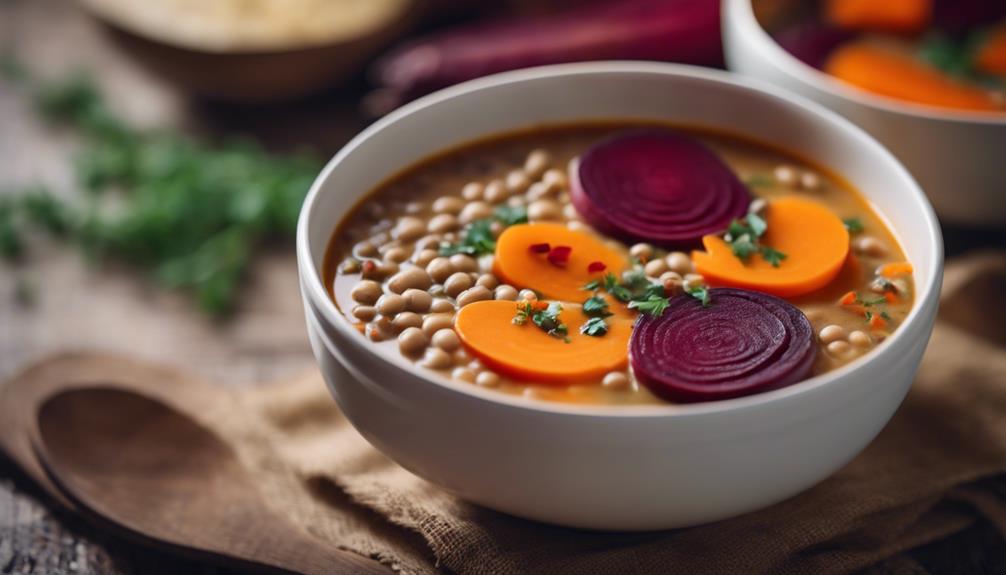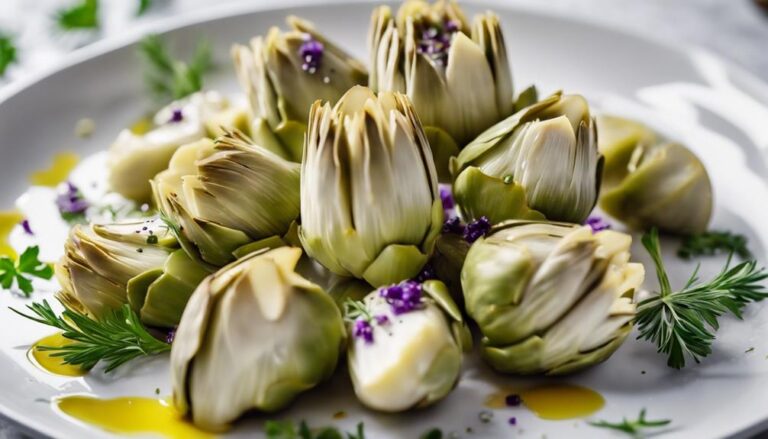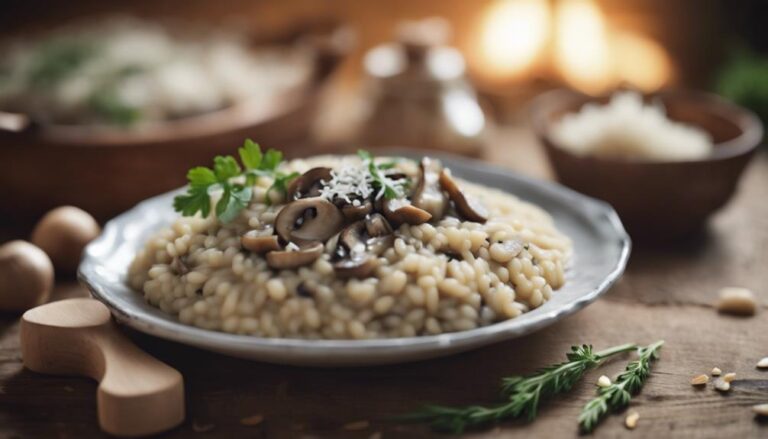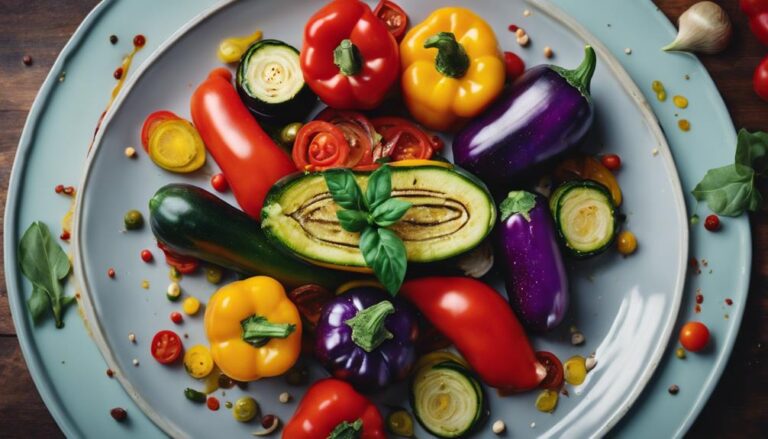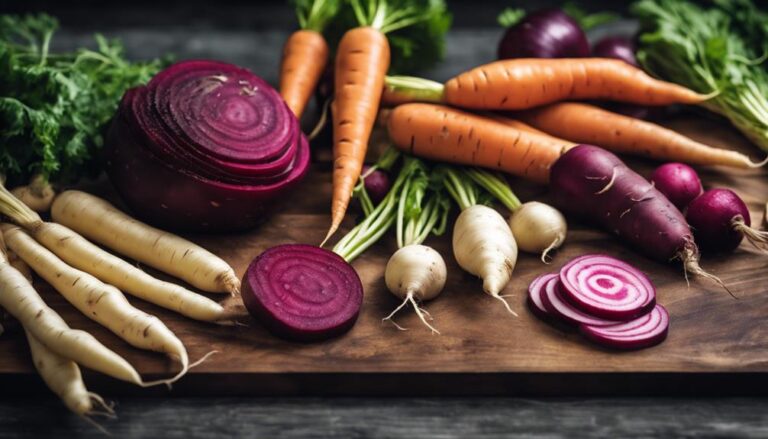Sous Vide Lentil Soup With Root Vegetables
For a perfectly cooked sous vide lentil soup with root vegetables, guarantee precise temperature control with your Anova Sous Vide Precision Cooker set to 180°F (82°C). This method promises even cooking, optimal flavor retention, and absorption of seasonings. The consistent cooking process softens ingredients without losing flavors, intensifying the natural taste of the root vegetables in a deliciously seasoned soup. Enjoy consistently flavorful and tender results, avoiding overcooking or undercooking. Your culinary skills will shine as you create a harmonious blend of earthy lentils, vibrant root veggies, and rich aromatic broth. Master this technique for a nutritious and flavorful meal.
What You Will Learn Here
- Sous vide cooking ensures precise temperature control for perfectly cooked lentils and root vegetables.
- Root vegetable medley mix offers a sweet and savory flavor profile with added nutrients.
- Anova Sous Vide Precision Cooker at 180°F guarantees uniform cooking and ideal flavor retention.
- Consistent results with minimal risk of overcooking or undercooking for a rich and satisfying soup.
- A balanced, nutritious, and flavorful meal option that aligns with a healthy lifestyle and allows personalization with herbs and spices.
Origin of Sous Vide
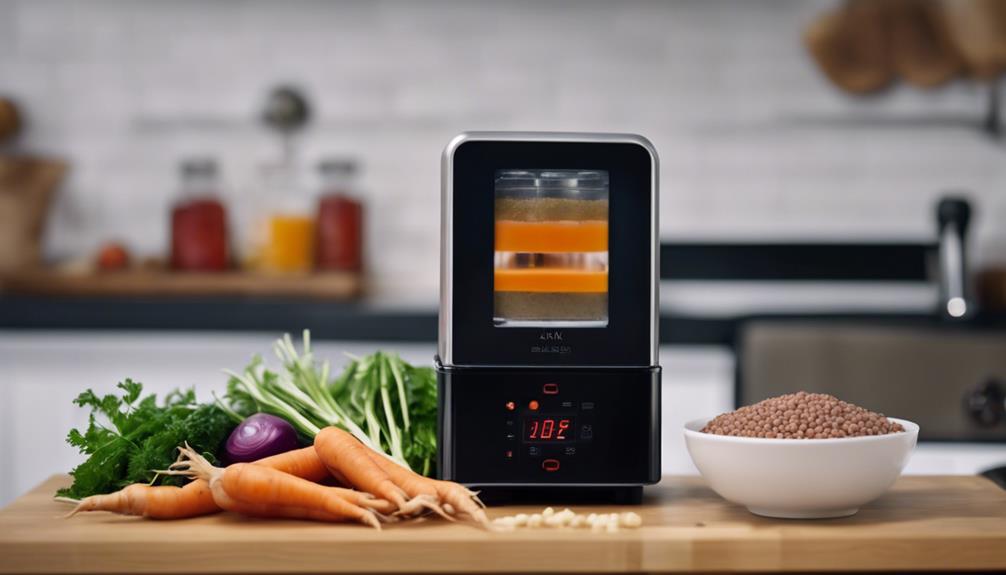
The concept of sous vide cooking originated in 18th century France. It evolved from a method of food preservation to a precise cooking technique. The term 'sous vide' itself, translating to 'under vacuum' in French, reflects the vacuum-sealing process integral to this method.
Understanding the history of sous vide provides insights into its development and the benefits it offers in modern culinary practices.
Sous Vide History
Originating from French, sous vide derives its name from the phrase 'under vacuum,' denoting the method of vacuum-sealing food for precise water bath cooking. The sous vide technique was pioneered by French chef Georges Pralus in the 1970s to achieve even cooking of foie gras. Initially embraced by professional kitchens for its consistent results, sous vide eventually shifted to home kitchens with the introduction of immersion circulators.
This method allows for precise temperature control, ensuring ideal flavors, textures, and juiciness in a variety of dishes. Sous vide has evolved from its origins to become a popular culinary trend, offering a unique way to elevate the cooking experience both in professional settings and for home cooks.
Modern Sous Vide
Pioneering the evolution of sous vide cooking from high-end restaurant kitchens to widespread home use, the modern adaptation of this technique has revolutionized culinary precision and flavor enhancement.
Sous vide, originating in the 1970s in France, involves sealing food in airtight bags and cooking it in a precisely controlled water bath. This method, popular for proteins like meat and fish, allows for consistent results and ideal tenderness.
When applied to dishes like lentil soup, sous vide guarantees flavors are locked in, resulting in a rich and hearty taste. By cooking at lower temperatures for extended periods, sous vide retains nutrients and enhances the overall texture and juiciness of ingredients, demonstrating its versatility and ability to elevate various recipes.
Sous Vide Benefits
With its roots in the culinary landscape of 1970s France, sous vide cooking emerged as a groundbreaking method for achieving unparalleled precision in temperature control during food preparation.
The sous vide technique involves sealing ingredients in airtight bags and cooking them in a water bath at precise temperatures. This method guarantees that foods retain their moisture, flavors, and nutrients, including vitamin C, which is often lost through traditional cooking methods.
By cooking food evenly at low temperatures for an extended period, sous vide preserves the nutritional content of ingredients, leading to healthier meals.
The controlled environment of sous vide cooking also helps enhance the natural flavors of foods, resulting in dishes that aren't only nutritious but also delicious.
Root Vegetable Medley Mix

The root vegetable medley mix for the sous vide lentil soup combines carrots, parsnips, and apricot marmalade to create a delightful sweet and savory blend. When preparing this mix, remember to drizzle it with a touch of olive oil to enhance the flavors and textures. Here are three key elements of the root vegetable medley mix:
- Carrots: The vibrant orange carrots provide a hint of natural sweetness and a pop of color to the dish, adding freshness and earthy notes.
- Parsnips: With their slightly nutty and sweet flavor, parsnips offer a unique taste that complements the carrots, creating a well-balanced medley.
- Apricot Marmalade: The apricot marmalade not only adds a touch of sweetness but also contributes a tangy and fruity undertone, elevating the overall taste profile of the root vegetable mix.
Trending Sous Vide Dishes
Trending sous vide dishes include Sous Vide Carrot Mash, Sous Vide Beet Salad, and Sous Vide Parsnip Puree.
These dishes showcase the technique's ability to enhance flavors and textures while preserving nutrients.
Home cooks are increasingly drawn to these innovative recipes that offer a balance of taste and health benefits.
Sous Vide Carrot Mash
To achieve a velvety texture and intense flavor, consider preparing Sous Vide Carrot Mash using precision cooking techniques.
- Seal fresh carrots with butter, a hint of honey, and a sprinkle of salt in a vacuum-sealed bag.
- Set the sous vide machine to 183°F (84°C) and let the carrots cook for 1.5 hours to tenderize.
- After cooking, blend the carrots into a smooth puree, adjusting seasoning to taste.
Sous Vide Carrot Mash showcases the magic of sous vide, preserving the carrots' essence while elevating them into a luxurious side dish. Serve this vibrant mash alongside proteins or whole grains for a colorful and nutritious meal that will delight your guests.
Sous Vide Beet Salad
Enhance the flavors and textures of beets with precise temperature control through sous vide cooking, showcasing their versatility and creativity in a visually stunning Sous Vide Beet Salad.
- Vibrant Colors: Imagine a plate filled with deep red, golden, and candy-striped beets, each retaining its distinct hue.
- Tender Texture: Picture perfectly cooked beets that are tender throughout, offering a delightful bite with every forkful.
- Balanced Flavors: Envision the earthy sweetness of beets complemented by tangy vinaigrette, fresh herbs, and crunchy nuts for a harmonious taste experience.
Sous Vide Beet Salad not only elevates the humble beet but also provides a feast for the eyes and palate, making it a must-try dish for beet enthusiasts.
Sous Vide Parsnip Puree
Cook parsnips in a water bath at a precise temperature to achieve optimal results in creating Sous Vide Parsnip Puree, a trending dish in the sous vide cooking world. This technique guarantees the parsnips are cooked evenly, preserving their natural flavors and nutrients.
The addition of chicken stock enhances the savory profile of the puree, providing depth of flavor. When preparing Sous Vide Parsnip Puree, consider incorporating herbs like thyme or rosemary to elevate the taste profile further.
The result is a velvety smooth puree that can be served as a side dish or as a base for various culinary creations.
Sous Vide Temperature Recommendations
To achieve ideal results when cooking lentil soup with root vegetables sous vide, it's essential to maintain a precise temperature of 180°F (82°C).
This specific temperature guarantees even cooking and the preservation of natural flavors in the ingredients.
Ideal Temperature Ranges
Achieving ideal results in sous vide lentil soup with root vegetables hinges on maintaining the precise temperature of 180°F (82°C) throughout the cooking process. Using a large pot for sous vide cooking aids in temperature stability, ensuring that the lentils and root vegetables cook evenly.
At 180°F (82°C), the flavors from the vegetables and lentils meld together, creating a rich and flavorful soup. The tender texture of the ingredients is achieved through precise temperature control, resulting in a harmonious blend of taste and consistency.
Cooking within this temperature range guarantees a well-balanced final dish that's sure to satisfy your guests. Remember to monitor the temperature closely to achieve the best results in your sous vide lentil soup with root vegetables.
Time Considerations
Consider setting the Anova Sous Vide Precision Cooker to 180°F (82°C) for optimal results when preparing sous vide lentil soup with root vegetables. Cooking at this temperature guarantees that the lentils and vegetables reach ideal tenderness while preserving their original flavors and nutrients.
For the next time you make this dish, maintain the sous vide setup at 180°F (82°C) for a duration of 2 hours. This timeframe allows the ingredients to blend harmoniously, resulting in a rich and satisfying soup.
Precision Cooking Benefits
When adjusting the Anova Sous Vide Precision Cooker to 180°F (82°C) for sous vide lentil soup with root vegetables, you guarantee precise temperature control for even cooking and ideal flavor retention.
This precision cooking method ensures that the lentils and root vegetables are cooked uniformly, allowing them to soften without losing their flavors. By maintaining a constant temperature in a water bath, the ingredients can fully absorb seasonings and aromatics, resulting in a deliciously seasoned soup.
With sous vide cooking, the risk of overcooking or undercooking is minimal, leading to consistently flavorful and tender lentil soup every time. The controlled cooking environment of sous vide further enhances the natural flavors of the root vegetables, contributing to a rich and satisfying dining experience.
Final Thoughts
In conclusion, the Sous Vide Lentil Soup with Root Vegetables provides a balanced combination of nutrition, flavor, and convenience for a satisfying dining experience. This dish aligns well with a healthy lifestyle, offering a hearty and wholesome option for those seeking to nourish their bodies.
The sous vide cooking technique not only guarantees that the lentils and root vegetables preserve their nutrients but also enhances their taste by allowing them to cook in their juices. By incorporating a variety of herbs, spices, proteins, or extra vegetables, you can personalize this soup to fit your preferences while still preserving its health benefits.
Moreover, the simplicity of preparation, storage, and reheating makes it a practical choice for individuals focused on meal planning and efficiency in the kitchen. Following the precise instructions for sous vide cooking ensures a consistent and restaurant-quality result, enabling you to savor a delicious and nutritious lentil soup with root vegetables in the comfort of your home.
Frequently Asked Questions
Do I Have to Cook Lentils Before Adding to Soup?
You don't have to cook lentils before adding them to soup. By using the sous vide method, lentils absorb flavors perfectly, ensuring ideal texture. Cooking lentils in the soup bag maintains their shape, simplifying prep and enhancing taste.
Why Is My Lentil Soup Not Thick?
To thicken lentil soup, try cooking it longer uncovered. Use an immersion blender to partially blend for a thicker consistency. Adjust seasoning and let it rest before serving. These techniques can enhance texture and flavor.
How Long Does It Take for Vegetables to Soften in Soup?
When simmering in soup, vegetable tenderness varies. Carrots, celery, and onions soften in 1-2 hours; root veggies like parsnips and potatoes take 2-3 hours. Sous vide guarantees precise softening without nutrient loss. Time depends on size and type of veggies.
How Healthy Is Lentil Vegetable Soup?
Lentil vegetable soup offers a range of nutritional benefits. It's high in fiber for digestion and satiety, low in calories and fat for weight management, and rich in plant-based protein. The diverse vegetable mix provides essential vitamins and minerals for overall health.
Conclusion
To sum up, sous vide cooking offers precise temperature control and ideal flavor infusion for dishes like lentil soup with root vegetables.
By vacuum-sealing ingredients and cooking them in a water bath, you can achieve consistent results every time.
Experiment with different root vegetable combinations and explore the versatility of sous vide cooking for a truly delicious and nutritious meal.
